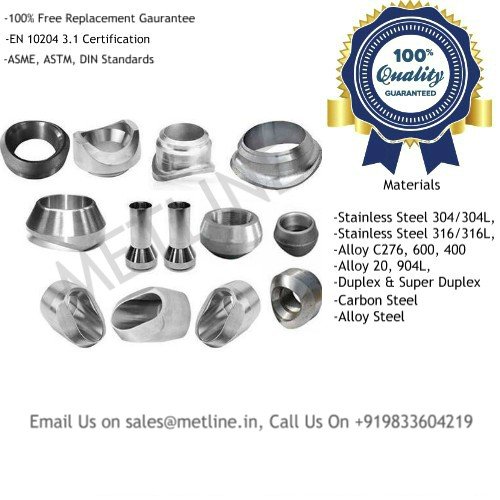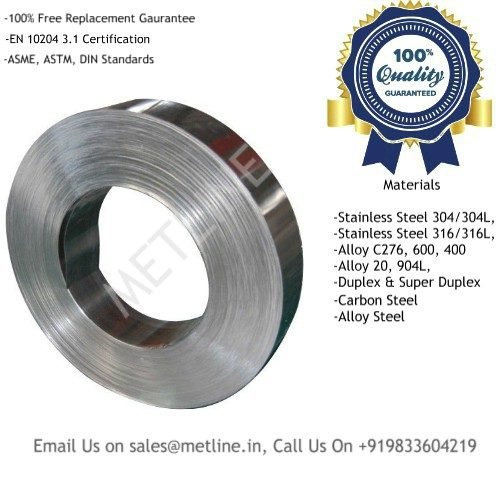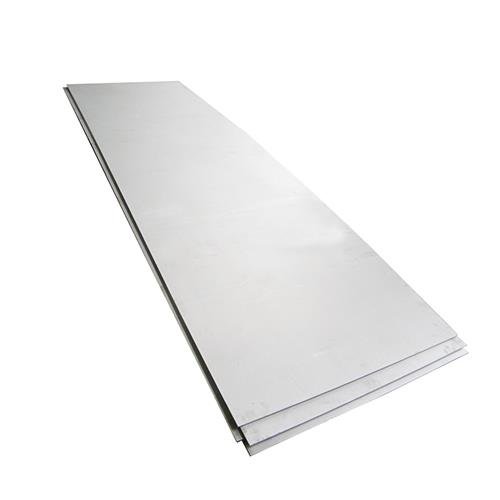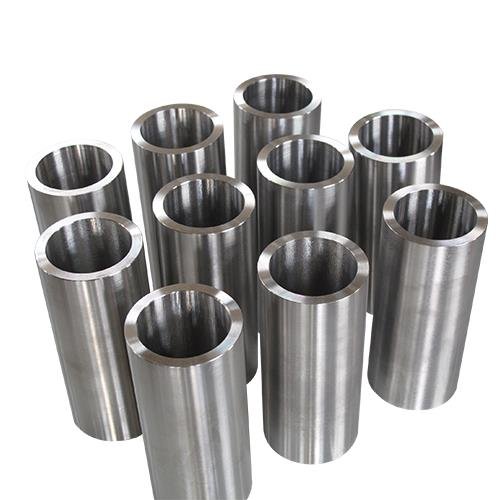Metline is a manufacturer and supplier of Titanium Outlet Fittings in sizes Outlet: 1/2″ to 8″, Run Pipe: 1/2″ to 60″ – SCH XXS. Metline specialises in supply of Titanium Welding Outlet, Titanium Socket Weld Outlets and Titanium Threaded Outlets. Titanium Outlets, are also commonly known as Titanium Branch Connection Fittings. These titanium outlet fittings may be available for sale under different names. and are manufactured in line with international standards ANSI/ASME B16.9, ANSI/ASME B16.25 or MSS SP-97.
Titanium alloys provide a high strength-to-weight ratio, while bridging the gap between the properties of steel and aluminum. Metline offers forged Titanium Outlet’s in Grade 1, Grade 2, Grade 3, Grade 5, Grade 7, Grade 9, Grade 12, Grade 16 titanium and its alloys. Titanium and Titanium Alloy Outlet’s find application in various industries such as pulp and paper industry, water and seawater service, chemical processes involving oxidizing media and oxidizing acids.
Our Titanium Outlet Production & Supply Range Includes
- Titanium Welding Outlet
- Titanium Socket Weld Outlets
- Titanium Threaded Outlets
- Titanium Butt Welding Outlet
- Titanium Outlet BW/SW
Titanium Outlets Manufacturing & Supply Range from Metline
| Product |
Titanium Outlets |
| Type |
- Titanium Welding Outlet
- Titanium Socket Weld Outlets
- Titanium Threaded Outlets
|
- Titanium Butt Welding Outlet
- Titanium Outlet BW/SW
|
| Material |
Pure Titanium or Titanium Alloy Gr1, GR2, GR3, GR5, GR7, GR9, GR12 |
| Sizes, Class or Schedule/Pipe Wall |
- Outlet Size
- Run Pipe Size
|
|
- Class 3000 or 6000 – Threaded or Socket
|
- STD, XS, Sch 160/XXS, ect. – Buttweld
|
| Standard |
ANSI/ASME B16.9, ANSI/ASME B16.25 or MSS SP-97, Custom Drawings |
| Technique |
Forging, Machining |
| Surface finished |
Pickling, Sand Blasting, Polishing |
| Quality control |
100% of the X-Ray Detection (RT), 100% UT |
| 100% of Surface Penetrant Inspection (PT) |
Manufacturing Standards for Titanium Outlet Fittings, Branch Connection Fittings
ASME B16.9 – Factory-Made Wrought Buttwelding Fittings
MSS SP-97 – Integrally Reinforced Forged Branch Outlet Fittings – Socket Welding, Threaded, and Buttwelding End
How to Order Titanium Outlet Fittings or Titanium Branch Connection Fittings
- Specify Size
- Outlet size
- Run or Header
- Specify Style
- Welding Outlet (Buttweld Type)
- Threading Outlet (Threaded Type)
- Socket Weld Outlet (Socket Type)
- Elbow Outlet, Lateral Outlet, Sweep Outlet, Insert Welding Outlet, Nipple Outlet, ect.
- Indicate Class or Schedule/Pipe Wall
- Class 3000 or 6000 – Threaded or Socket
- STD, XS, Sch 160/XXS, ect. – Buttweld
- Specify Design Code (if available)
- Manufacturing Standard
Titanium Pipe Fittings Manufacturing & Supply Range
| Size |
1/2″ NB to 24″ NB in SCH 10S, 40S, 80S, 160S, XXS, or according to Customer’s Drawings and Specifications – (DN15-DN1200) |
| Specification |
ASTM B363 / ASME SB 363, ASME, DIN, JIS etc. |
| Type |
Seamless, Welded, Fabricated Ti Pipe Fittings |
| Dimensions |
ANSI/ASME B16.9, B16.28, MSS-SP-43, ANSI B16.11 |
| Grade |
• CP Ti Grades 1, 2, 3, 4, 7/11, 12, 33
• Ti 6Al-4V, Ti 6Al-4VELI, Ti-3Al-2.5V, Ti6242 (6Al-2Sn-4Zr-2Mo),
• Ti 811 (8Al-1Mo-1V), Ti13-11-3 (13V-11Cr-3Al), Ti5-2.5 (5Al-2.5Sn), Ti 15-333 (15V-3Al-3Cr-3Sn) |
| Products |
Titanium Elbows, Titanium Tee, Titanium Reducer, Titanium Stub Ends, Titanium End Caps, Titanium Bends |
Comparison of Various Titanium Grades – Chemical & Mechanical Properties of Titanium Sheets
| ASTM B265 |
Fe max |
O max |
N max |
C max |
H max |
Pd |
Al |
V |
Mo |
Ni |
Elongation |
Rp 0.2 |
Rm |
| No |
wt% |
wt% |
wt% |
wt% |
wt% |
wt% |
wt% |
wt% |
wt% |
wt% |
% |
YS – MPa |
UTS – MPa |
| Grade 1 |
0.2 |
0.18 |
0.03 |
0.1 |
0.015 |
|
|
|
|
|
24 |
170—310 |
240 |
| Grade 2 |
0.3 |
0.25 |
0.03 |
0.1 |
0.015 |
|
|
|
|
|
20 |
275—450 |
345—480 |
| Grade 3 |
0.25 |
0.3 |
0.05 |
0.1 |
0.015 |
|
|
|
|
|
18 |
360—480 |
480—700 |
| Grade 4 |
0.5 |
0.4 |
0.05 |
0.1 |
0.015 |
|
|
|
|
|
15 |
500—530 |
600—680 |
| Grade 5 |
0.4 |
0.2 |
0.05 |
0.1 |
0.015 |
|
5.5-6.7 |
|
|
|
10 |
800—1100 |
890—1400 |
| Grade 6 |
|
|
|
0.1 |
|
|
|
|
|
|
16 |
780—820 |
820—860 |
| Grade 7 |
0.3 |
0.25 |
0.03 |
0.1 |
0.015 |
0,12-0,25 |
|
|
|
|
20 |
275—450** |
345 |
| Grade 9 |
0.25 |
0.15 |
0.02 |
0.05 |
0.015 |
|
2,5—3,05 |
|
|
|
15 |
550 |
650 |
| Grade 11 |
0.2 |
0.18 |
0.03 |
0.1 |
0.015 |
0.12—0.25 |
|
|
|
|
24 |
170-310** |
240 |
| Grade 12 |
0.3 |
0.25 |
0.03 |
0.1 |
0.015 |
|
|
|
0.3 |
0.8 |
25 |
414—460 |
499—600 |
| Grade 13 |
|
|
|
|
|
|
|
|
|
0.5 |
|
|
|
| Grade 14 |
|
|
|
|
|
|
|
|
|
0.5 |
|
|
|
| Grade 15 |
|
|
|
|
|
|
|
|
|
0.5 |
|
|
|
| Grade 16 |
|
|
|
|
|
0.04—0.08 |
|
|
|
|
27 |
345 |
485 |
| Grade 17 |
|
0.18 |
|
|
|
0.04—0.08 |
|
|
|
|
35 |
206 |
345 |
| Grade 18 |
|
|
|
|
|
0.04—0.08 |
3 |
2.5 |
4 |
|
|
|
|
| Grade 19 |
|
|
|
|
|
|
3 |
8 |
4 |
|
|
|
|
| Grade 20 |
|
|
|
|
|
0.04—0.08 |
3 |
8 |
4 |
|
|
|
|
| Grade 21 |
|
|
|
|
|
|
3 |
|
15 |
|
15—8 |
880—1250 |
915—1350 |
Various Titanium Grades & their UNS Designations
| Grades |
UNS |
Grades |
UNS |
| CP Grade 1 |
R50350 |
CP Grade 2 |
R50400 |
| CP Grade 3 |
R50550 |
CP Grade 4 |
R50700 |
| Titanium Grade 6 |
R54520 |
CP Grade 7 |
R52400 |
| Titanium Grade 9 |
R56320 |
CP Grade 11 |
R52252 |
| CP Grade 12 |
R53400 |
CP Grade 16 |
R52402 |
| CP Grade 17 |
R52252 |
CP Grade 26 |
R52404 |
| CP Grade 27 |
R52404 |
Titanium Grade 28 |
R56323 |
| Titanium Grade 29 |
R56404 |
Ti-10V-2Fe-3Al |
R56410 |
| Ti-13V-11Cr-3Al3-8-6-44 |
R58010 |
Ti-2.5Cu |
– |
| Ti-3Al-8V-6Cr-4Mo-4Zr |
– |
Ti-4Al-4Mo-2Sn |
– |
| Ti-5-2.5Sn ELI |
R54521 |
Ti-5.8Al-4.0Sn-3.5Zr-0.7Nb-0.5Mo-0.35Si-0.06C |
– |
| Ti-5Al-1Sn-1Zr-1V-0.8Mo |
– |
Ti-5Al-2Zr-2Sn-4Mo-4Cr |
R58650 |
| Ti-6Al-2Sn-2Zr-2Mo-2Cr-0.15Si |
R56222 |
Ti-6Al-2Sn-4Zr-2Mo |
R54620 |
| Ti-6Al-2Sn-4Zr-6Mo |
R56260 |
Ti-6Al-4V |
R56400 |
| Ti-6Al-4V ELI |
R56407 |
Ti-6Al-6V-2Sn |
R56620 |
| Ti-6Al-7Nb |
R56700 |
Ti-7Al-4Mo |
R56740 |
| Ti-8Al-1Mo-1V |
R54810 |
|
|
Various Titanium Alloys – Manufactured & Supplied Worldwide
Grade 1 :Unalloyed Titanium. Relatively low strength, high ductility and excellent weldability. Highly corrosion resistant in oxidizing and mildly reducing environments, including chlorides. Main use in heat exchangers.
Grade 2 :Unalloyed Titanium. Most widely used titanium in all product forms for industrial use, offering an excellent balance of moderate strength, ductility and weldability. Medium oxygen. Used in piping systems and heat exchanger tubing.
Grade 3 :Unalloyed Titanium. Offers optimum ductility and cold formability with useful strength, high-impact toughness, and excellent weldability. Highly corrosion resistant in oxidizing and mildly reducing environments, including chlorides. Main use in shell and tube heat exchangers.
Grade 4 :The highest strength pure unalloyed Titanium. High oxygen, extra high strength. Good corrosion resistance in neutral to oxidizing environments, including chlorides. Used in hydraulic and instrumentation tubing.
Grade 5 :Titanium alloy. 6% aluminium, 4% vanadium. Grade 5 is the most widely used titanium alloy. It has very high strength but relatively low ductility. The main application of this alloy is in aircraft and spacecraft. Offshore use is growing. The alloy is weldable and can be precipitation hardened.
Grade 6 :Titanium Alloy. Useful for applications requiring good weldability, stability and strength at elevated temperatures, such as airframe and jet engines.
Grade 7 :Unalloyed Titanium plus 0.12% to 0.25% palladium. Medium strength, standard oxygen. Most corrosion-resistant titanium alloy in reducing and oxidizing environments, with a good balance of moderate strength, reasonable ductility and excellent weldability. Physical and mechanical properties equivalent to Grade 2.
Grade 9 :Titanium alloy including 3% aluminium and 2.5% vanadium. Also known as “half 6-4”. 20-50% higher strength than C.P. grades, but has better weldability and higher tensile strength than the strongest unalloyed grade. Usual applications found in Aerospace, petrochemical, hydraulic & instrumentation tubing, sports and subsea applications.
Grade 11 :Unalloyed Titanium plus 0.12% to 0.25% palladium. This alloy is the same as Grade 1, but with palladium added for better corrosion resistance. Low oxygen. Low strength. Especially suitable for deep drawing requiring optimum ductiility and cold formability. Also has excellent weldability.
Grade 12 :Titanium alloy including 0.3% molybdenum, 0.8% nickel. High strength. Good heat, wear and corrosion resistance. Used for shell and heat exchangers, hydrometallurgical applications.
Grade 13 :Titanium alloy including 0.5% nickel and 0.05% ruthenium. Low oxygen.
Grade 14 : Titanium alloy including 0.5% nickel and 0.05% ruthenium. Standard oxygen.
Grade 15 : Titanium alloy including 0.5% nickel and 0.05% ruthenium. Medium oxygen.
Grade 16 :Unalloyed Titanium plus 0.04% to 0.08% palladium. Standard oxygen, medium strength. Has a good balance of moderate strength, reasonable ductility and excellent weldability. Used in chemical industries because of its outstanding corrosion resistance.
Grade 17 :Unalloyed Titanium plus 0.04% to 0.08% palladium. This alloy is the same as Grade 1, but with palladium added for better corrosion resistance. Grade 17 has optimum ductility and cold formability with useful strength, high-impact toughness, and excellent weldability. Very resistant to crevice corrosion.
Grade 18 :Titanium alloy including 3% aluminium, 2.5% vanadium plus 0.04% to 0.08% palladium.
Grade 19 :Titanium alloy including 3% aluminium, 8% vanadium, 6% chromium, 4% zirconium, 4% molybdenum.
Grade 20 :Titanium alloy including 3% aluminium, 8% vanadium, 6% chromium, 4% zirconium, 4% molybdenum plus 0.04% to 0.08% palladium. Beta – 21S is a metastable beta alloy that offers high specific strength and good formability, and has been designed for improved oxidation resistance, elevated temperature strength, creep resistance and thermal stability, especially in applications above 300°C.
Grade 21 :Titanium alloy including 15% molybdenum, 3% aluminium, 2.7% niobium, 0.25% silicon. Titanium alloy including 6% aluminium, 4% vanadium, and extra low interstitial, ELI23 Alloy 23 is an alpha-beta alloy based on Grade 5, providing improved stress corrosion cracking properties in seawater. Especially suited for thick wall highly stressed parts.
Grade 24 :Titanium alloy including 6% aluminium, 4% vanadium plus 0.04% to 0.08% palladium.
Grade 25 :Titanium alloy including 6% aluminium, 4% vanadium plus 0.3% to 0.8% nickel, 0.04% to 0.08% palladium.
Grade 26 :Unalloyed Titanium plus 0.08% to 0.14% ruthenium. Standard oxygen, medium strength. A corrosion-resistant titanium alloy offering outstanding resistance to general and localised crevice corrosion in a wide range of oxidizing and reducing acid environments including chlorides. Has a good balance of moderate strength, reasonable ductility and excellent weldability. Mechanical properties similar to Grade 2, but improved corrosion resistance. A competitive alternative to 7.
Grade 27 :Unalloyed Titanium plus 0.08% to 0.14% ruthenium. Low oxygen, low strength, and is the same as Grade 1, but with Ruthenium for better corrosion resistance, Grade 27 has optimum ductility and cold formability with useful strength, high-impact toughness, and excellent weldability. Very resistant to crevice corrosion.
Grade 28 :Titanium alloy including 3% aluminium, 2.5% vanadium, plus 0.08% to 0.14% ruthenium. High strength with enhanced corrosion alternative to 9.
Key Characteristics, Advantages of Using Titanium Metals, Titanium Elbow, Ti Fittings
| High Strength |
Titanium strength/density ratio is better than other metals, components with high strength, good rigity, less weight can be made out of titanium. Titanium is applied for aircrafts engines, frames, skins, fastners and landing gears. |
| Anti-Corrosion |
Compared with stainless steel, titanium alloy’s corrosion is better in moisture laden air, seawater, titanium greatly resists spot corrosion, acid corrosion and stress corrosion. Titanium resists corrosions to alkali, chloride, chlorinated organic sunstances, sulphuric acid, nitric acid. |
| High-Temperature Resistance |
Titanium application temperature’s higher than aluminium alloys. Titanium can work in 450-500℃ for long time. Titanium alloy stil prossesses high strength when working in 150-500℃. Titanium working temperature can be reached to 500℃ |
| Low Temperature Resistance |
Titanium alloys still owns its mechanical properties when working in low or super low temperature conditions. Titanium alloys with low-temperature resisitance and extra low interstitial still possess good ductility, therefore, titanium alloy is sort of good low temperature structural material. |
| Eco-Friendly Metal |
Thermal conductivity of titanium is lower than carbon steel or copper, but titanium owns very good corrosion resistance, therefore, titanium thickness can be greatly reduced, also the heat exchange mode is dropwise condensation between titanium and steam. This kind of mode reduces heat transfer resistance, no fouling on titanium surface, which makes titanium thermal conductivity better. |
| Good Thermal Conductivity |
Titanium is non-magnetic metal, it can’t be magnetized in large magnetic field, also titanium is toxic-free and compatibility with blood, there, titanium is applied in medical field. |






Reviews
There are no reviews yet.